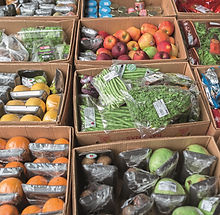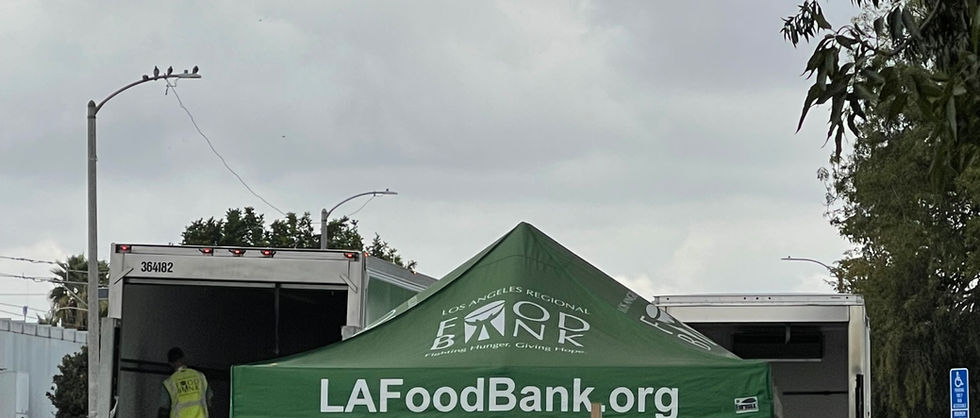LA Regional Food Bank
Mobile Interface Design
Tools
Figma, Photoshop, Illustrator
Concept
Design & develop a solution for food insecurity
Timeline
September - December 2021
Team
Mathias Moslehi, Christian Suarez, Andres Munoz
My Role
Project Manager, User Research & Interview, UX Design, Concept Design, User Testing

Challenge
In our design studio class we were tasked with finding a solution for reducing food waste. My team decided to perform research and conduct interviews at our local grocery stores and food banks. Our research led us to focus on finding a solution for the food waste happening at the Los Angeles Regional Food Bank.
Problem
Through our conversations with the staff at the Los Angeles Regional Food bank we learned that their biggest challenge is determining what food products their recipients want or need. Additionally many recipients have dietary restrictions and can't consume the products that come in a prepackaged box and throw them away.
Solution
The Los Angeles Regional Food Market App is a mobile application that lets recipients customize their own box by selecting from available food items. Recipients register on the app, select their items, choose a pick up location, place their order and then use a QR code to pick up their box. By giving them food options they will reduce their food waste by almost 63%.
How might we create a tool for the LARFB to help them streamline and improve their acquisition system; while at the same time addressing needs of the community and reducing food waste?

What does the community need?
We wanted to understand what the community needed the most, so we conducted research and interviews to pin point where the issues were happening.

Surveys show that roughly 44 million people experience hunger in the US. That number is unconsciously high given that 38% of food is unsold or uneaten

Overproduction
Overproduction and market saturation create food waste as such the supply and demand models need to be reevaluated and improved on

Grocery Stores
Retailers and Food Banks in Los Angeles need an easier way to track food and distribute it where it is needed because many of them have surplus food that is being wasted
Food Waste happens at food banks too
Initially our team focused on tackling food waste in the food retail sector but after we interviewed grocery store owners we discovered that many retailers were already trying to reduce food waste by partnering with their local food banks. This discovery led us to observe and reach out to the Los Angeles Regional Food Bank. Upon observation we were surprised to learn that many perfectly good food items are left behind or thrown out.
Going right to the source

Jeanna Kindle
Chief Acquisition Officer
"The most difficult part of my job is to determine what the people want or need. I usually ask for product recommendations from my colleagues or other managers in the operations team."
We got an opportunity to talk to Jeanna, the Chief Product Acquisition Officer for the Los Angeles Regional Food Bank. Her role is to secure food products from local and federal sources. In our interview she expressed that it was difficult to understand what products the community really wanted. She also expressed the lack of manpower many food bank facilities face.
What does the community need?
We know what the business needs but what do the recipients need? To visualize this we created a user persona to better define our demographic. This is Loraine, she was recently laid off and needs food assistance. Often the products she receives from the food bank aren't tailored to her dietary needs and the box is too heavy for her to carry. Because of these pain points she would throw out or give away a lot of what she couldn’t eat.

Mapping out Loraine's Pain Points
To further understand the problem, we also created a user journey map for Loraine. This helped us visualize and understand the specific obstacles she faces when ordering and picking up products.

Pain points for both business and customer
1.
Prepackaged boxes do not offer customization
2.
Avoid food allergies within prepackaged boxes
3.
Prepackaged boxes are too heavy for recipients to carry
4.
There isn't enough manpower to oversee a physical market for recipients
5.
How do we survey what people actually want?
6.
How do we make it easy for recipients to pickup their items?
Exploring ways to tackle this issue
After conducting a lot of research, conceptualizing different ideas and synthesizing lots of data, we decided that our solution needed to make it easy for LARFB recipients to register, select a pickup date and location and select products. Because we didn’t have a product in our particular sector to use for reference, we looked at mobile applications like Amazon fresh and Instacart to gain an understanding of how users select and pickup their items.
Prototype Sketches

Initial Sitemap

Initial Low-Fi Prototype
.png)
Keeping the style guide consistent with LARFB
.png)
.png)
.png)
Key App Features

Onboarding Screens

Item Selection

Pick-Up via QR Code
User Testing & Iterations
In order to test our app we created low-fidelity wireframes through Figma. Our focus was to test registration, navigation, product selection, pickup date/time and confirmation. We reached out to several users and non users through Zoom to navigate our product and give us feedback.

Before
Onboarding screens would be helpful, QR code is a good idea

After
Added 4 onboarding screens to help user navigate

Before
Icons in navigation are hard to understand

After
Updated icons through customization

Before
Unclear that product categories can be browsed left to right

After
Product categories are offset to signify left right scroll

Before
Box weight is important for use without cars
.png)
After
Added total weight of items in the box
Final Prototype

Recipients customize their own box by selecting from available food items
Onboarding screens allows recipients to navigate and understand actions within the app.
Our app reduces ordering of unpopular foods and limits waste produced by the organization. It also reduces warehouse space needed to store unpopular or expiring produce.
Multiple Food Options
One of the bigger issues for LARFB was to improve the acquisition system. One way to accomplish this was by offering users the opportunity to choose the items they need.
In exchange, the organization gains an opportunity to better understand their community needs and desires.


Customized Box
Customized boxes gives recipients choices, items details, and box weight which reduces operational cost and streamlines scheduling of volunteers.
It also offers users more opportunity to access and understand LARFB’s services without needing manpower at abnormal hours.
Order Summary
The order summary page gives recipients the ability and convenience to pick a time and a location.


Unique Product
Options to save the QR code for easy retrieval makes this a unique opportunity for LARFB to create a new standard in community service.
There isn’t anything else out there, and this helps empower individuals.
What I learned along the way
Initially our team started out trying to tackle food waste in the food retail sector. We interviewed several grocery store owners and discovered that many retailers were already trying to reduce food waste by partnering with their local food banks. This discovery led us to reach out to the LARFB in search for what they may need help with. Through our interviews we got our "aha" moment and quickly pivoted our project to helping them. Getting to that point took a lot of team meetings, research and synthesizing, all of which taught me to value the design process. Furthermore I learned to take myself out of the equation and focus on designing for our demographic.
I am truly proud of this project and especially proud of my team members, we put in a lot of hours through Zoom. They are a very talented and committed team, we learned a lot from each other and learned a lot about our work ethic.
I wish to continue pursuing this project further and present it to the LARFB stakeholders and get their input. I especially look forward to actually implementing this app as it could benefit a lot of people.





.png)